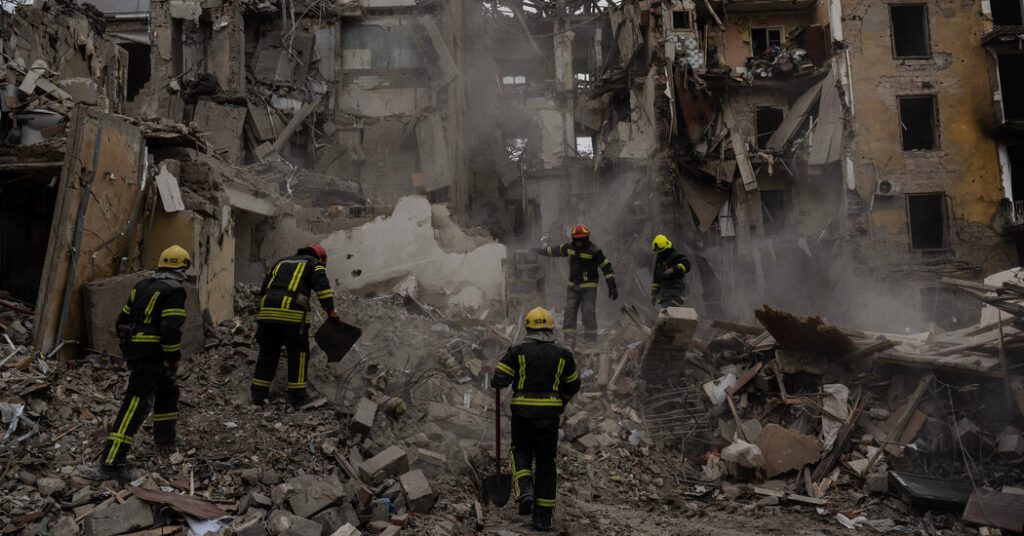Welcome to the Russia-Ukraine War Briefing, your guide to the latest news and analysis about the conflict.
To our readers
We started this newsletter as Russia massed troops at the border with Ukraine, nearly one year ago. On Feb. 24, those troops invaded Ukraine from the north, east and south, shelling more than a dozen cities. Europe’s biggest land war since World War II had begun.
Predictions that Kyiv would fall within days turned out to be very wrong. Months of bitter fighting followed. Now, Russia and Ukraine are gearing up for new offensives. There seems to be no prospect of a diplomatic solution in the near future.
With both sides locked in a fight that is expected to grind on for months or even years, it’s clear that the war is in a much different phase than it was in a year ago. We’ve decided to shift our approach to covering the conflict by pausing this newsletter.
The Times is still devoting vast journalistic resources to covering the war and its effects on the world, and you can continue to read The Times’s in-depth coverage of the war here and in our sister newsletters The Morning and the Evening Briefing, as well as others that you’ll see below.
I’d like to thank the many people who worked to make this newsletter your go-to guide for news about Ukraine: Yana Dlugy was at the helm as lead writer for four months. Our Kyiv bureau chief, Andrew Kramer, and our Moscow bureau chief, Anton Troianovski, shared many insights over the past months, as did the photographer Lynsey Addario and several other correspondents.
As for me, I’m glad I was able to help keep you informed about this devastating war and its far-reaching implications, even if the news was usually not happy. We’ll continue to report on the war in Ukraine and are ready to bring the newsletter back if events warrant it.
Now let’s turn to the latest news.
The U.S. sends longer-range weapons
A $2.2 billion package of U.S. military aid announced today will, for the first time, allow Ukraine to acquire long-range bombs that can strike targets more than 90 miles away.
The Ground-Launched Small Diameter Bomb uses a rocket motor to boost a 250-pound munition into the air, where it deploys scissor-like wings and glides to its target, guided by satellites. Developed by Boeing and Saab, the weapon is brand-new and has not been fielded by the U.S. military.
The package also included more Guided Multiple Launch Rocket System munitions that the Pentagon had previously provided to Ukraine. Those have a range of about 52 miles and carry a warhead containing 200 pounds of explosives.
President Volodymyr Zelensky thanked President Biden for the new aid package. “The more long-range our weapons are and the more mobile our troops are the sooner Russia’s brutal aggression will end,” he said on Twitter.
The new rockets, like the Abrams tanks announced last month, will most likely not be delivered for several months, if not years. Still, the pledges signal to Russia that Ukraine’s military will eventually be equipped with tanks and other advanced weaponry that would enable it to mount counteroffensives to take back territory seized by Moscow.
Meanwhile, as Russia steps up attacks in the Donbas, Ukraine’s hold on the city of Bakhmut has grown increasingly precarious. Russia has flooded the area with troops in a new attempt to force Ukraine into retreat and secure what would be its first significant victory in months.
But Zelensky insisted today that “no one will give away Bakhmut,” adding: “We consider Bakhmut to be our fortress.”
Capturing the city would hardly guarantee that Moscow’s troops could make further advances. Russia’s forces would still have to capture more than 40 percent of Donetsk Province to claim the entire Donbas region, which is the mission laid out by President Vladimir Putin.
Here is a brief look at points on the front line where Ukraine has faced increased pressure in recent weeks.
JOIN US ON TELEGRAM
Follow our coverage of the war on the @nytimes channel.
What else we’re following
In Ukraine
In Russia
We also recommend
Thanks for reading. Goodbye, for now. — Carole
Email your thoughts to warbriefing@nytimes.com. Did a friend forward you the briefing? Sign up here.

